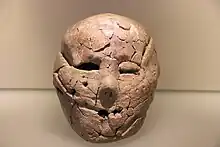Plastered human skulls
Plastered human skulls are human skulls covered in layers of plaster, typically found in the ancient Levant, most notably around the modern Palestinian city of Jericho, between 8,000 and 6,000 BC (approximately 9000 years ago),[1][2] in the Pre-Pottery Neolithic B period. They represent some of the oldest forms of art in the Middle East and demonstrate that the prehistoric population took great care in burying their ancestors below their homes. The skulls denote some of the earliest sculptural examples of portraiture in the history of art.[3]
| Plastered human skulls | |
|---|---|
 | |
| Material | Plaster and bone |
| Created | 8000–6000 BC |
| Present location | Palestine |
Discovery
One skull was accidentally unearthed in the 1930s by the archaeologist John Garstang at Jericho, in Palestine. A number of plastered skulls from Jericho were discovered by the British archaeologist Kathleen Kenyon in the 1950s and can now be found in the collections of the British Museum, the Ashmolean Museum, the Cambridge Museum of Archaeology and Anthropology, the Royal Ontario Museum, the Nicholson Museum in Sydney and the Jordan Archaeological Museum.[4][5][6]
Other sites where plastered skulls were excavated include Ain Ghazal near Amman, Jordan, and Tell Ramad in Syria.[7] Most of the plastered skulls were from adult males, but some belonged to women and children.
Archaeological significance
The plastered skulls represent some of the earliest forms of burial practices in the southern Levant. During the Neolithic period, the deceased were often buried under the floors of their homes.[7] In other words, a plaster skull sometimes went under a plaster floor. Sometimes the skull was removed, and its cavities filled with plaster and painted. In order to create more lifelike faces, shells were inset for eyes, and paint was used to represent facial features, hair, and moustaches.[7][8]
Some scholars believe that this burial practice represents an early form of ancestor worship, where the plastered skulls were used to commemorate and respect family ancestors.[7] Other experts argue that the plastered skulls could be linked to the practice of head hunting, and used as trophies although there is scarce evidence to support this. Plastered skulls provide evidence about the earliest arts and religious practices in the ancient Near East.
Epigraphy
The only possible written reference known to history is in the Tale of Aqhat. "A mortal, what does he get in the end? What does a mortal finally get? Glaze poured on his head, lime on top of his skull." [9]
Gallery
 Plastered skulls on exhibition at the Israel Museum, Jerusalem
Plastered skulls on exhibition at the Israel Museum, Jerusalem Plastered skull from Beisamoun (replica), PPNB, Museum of Prehistory, Haifa
Plastered skull from Beisamoun (replica), PPNB, Museum of Prehistory, Haifa Plastered skulls in situ at Yiftahel, Pre-Pottery Neolithic B
Plastered skulls in situ at Yiftahel, Pre-Pottery Neolithic B
References
- "JERICHO SKULL". www.ashmolean.org. Retrieved 25 May 2022.
- Newitz, Annalee (12 December 2016). "This man's skull was ritualistically transformed 9,000 years ago in Jericho". Ars Technica. Retrieved 25 May 2022.
- Kleiner, Fred S. (2012). Gardner's Art through the Ages: Backpack Edition. Cengage Learning. p. 42. ISBN 9780840030542.
- ROM Collection ROM Images. "Plastered Human Skull." Archived 2014-02-22 at the Wayback Machine
- "TREASURES | Ashmolean Museum". www.ashmolean.org. Retrieved 6 March 2018.
- "MAA - Features". maa.cam.ac.uk. Archived from the original on 22 February 2014. Retrieved 6 March 2018.
- "The British Museum. "Plastered Skull."". Archived from the original on 18 October 2015. Retrieved 15 June 2017.
- German, Senta. "The Neolithic Revolution."
- Coogan & Smith 2012, p. 42.
Further reading
- D. Collon, Ancient Near Eastern art (London, The British Museum Press, 1995)
- J.N. Tubb, Canaanites (London, The British Museum Press, 1998)
- German, Senta. “The Neolithic Revolution.” Khana Academy.
- Strouhal, E. Five Plastered Skulls from Pre-Pottery Neolithic B Jericho: Anthropological Study Paléorient 1:1-2 (1973): 231–247.
- Mazar, Amihai (1990). Archaeology of the land of the Bible (1st ed.). New York: Doubleday. ISBN 038523970X.
- Coogan, Michael D.; Smith, Mark S. (15 March 2012). Stories from Ancient Canaan, Second Edition. Louisville, KY: Westminster John Knox Press. ISBN 978-0-664-23242-9.